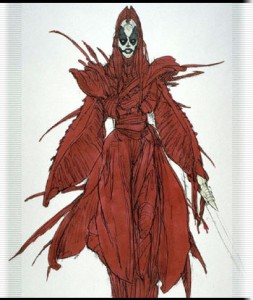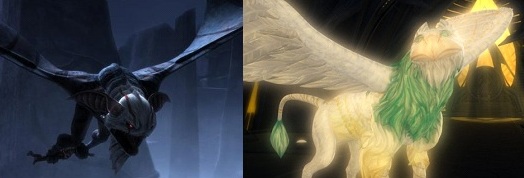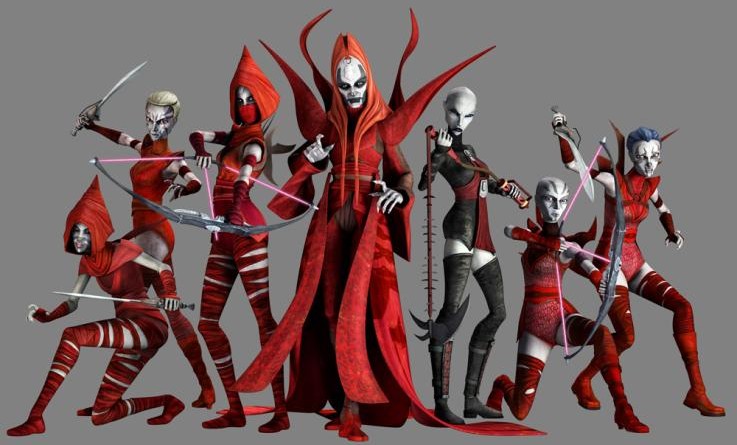The Magic of Star Wars – A Sith Witch and the Nightsisters Take Center Stage
 Cross-posted at Suvudu:
Cross-posted at Suvudu:
Ever since Uncle Owen dismissed Obi-Wan Kenobi as a crazy old wizard and Admiral Motti discounted Darth Vader’s mastery of the ways of the Force as an anachronistic ancient religion, Star Wars has drawn just as heavily on elements of magical fantasy stories as the physical trappings of science fiction. Mind control, telekinesis, clairvoyance, and summoned lightning came to define the Jedi and Sith as much as their lightsabers. With good and evil mages duking it out for the fate of the galaxy, it was only a matter of time before another iconic figure made her way into Star Wars, as well – the witch.
It didn’t take long. In 1994, as the emerging novel line began to grow rapidly after the conclusion of Timothy Zahn’s Thrawn Trilogy with The Last Command, Dave Wolverton’s The Courtship of Princess Leia introduced two matriarchal societies that have continued to play a lasting, significant role in the Expanded Universe: the Witches of Dathomir and the Hapes Consortium. While Han strove to prevent Leia from marrying Prince Isolder, son of the Hapan queen, to forge a political alliance for the nascent New Republic about four years after its victory in the Battle of Endor, Luke was drawn into a political crisis of his own: the conflict between the good witches of the Singing Mountain Clan and the evil Nightsisters. By the end of Courtship, Leia married Han, Hapes allied with the New Republic anyway, and Luke managed to avoid having to marry the witch Teneniel Djo, who ended up capturing the heart of Prince Isolder. Throughout the subsequent decades, the Hapans remained important allies of the New Republic and the Jedi during the crises and conflicts of the New Jedi Order, Dark Nest, Legacy of the Force, and Fate of the Jedi series. The Nightsisters maintained a presence as recurring villains, too, including in the Young Jedi Knights series and Fate of the Jedi: Backlash, as well as the Star Wars roleplaying game and miniatures game and the Star Wars Galaxies MMO and trading card game. Ultimately, as often occurs in Star Wars, fate eventually comes full circle: young Allana, heiress to the Hapan throne as Fate of the Jedi winds to a close next month, is the daughter of Jacen Solo and Tenel Ka – which means Courtship actually tells the story of the betrothal of both pairs of her grandparents.
 Over the last year, the Nightsisters and their unique witchcraft in the Star Wars galaxy have gained even more prominence in the tales told in The Clone Wars animated television series. In a trilogy of episodes late last season, fans were introduced to a Nightsisters clan led by Mother Talzin, whose haunting visage first took shape as concept art for a “Sith witch” character for Episode II (before the final decision was made to fill the role of Darth Sidious’ interim apprentice with Count Dooku). Talzin and her minions wielded their magic – particularly the mystical mists called green ichor – to grant invisibility to a team of ninja assassins led by Asajj Ventress, summon objects seemingly out of thin air, transform Savage Opress from an ordinary Zabrak to a hulking monstrosity, and bend his will to their wishes.
Over the last year, the Nightsisters and their unique witchcraft in the Star Wars galaxy have gained even more prominence in the tales told in The Clone Wars animated television series. In a trilogy of episodes late last season, fans were introduced to a Nightsisters clan led by Mother Talzin, whose haunting visage first took shape as concept art for a “Sith witch” character for Episode II (before the final decision was made to fill the role of Darth Sidious’ interim apprentice with Count Dooku). Talzin and her minions wielded their magic – particularly the mystical mists called green ichor – to grant invisibility to a team of ninja assassins led by Asajj Ventress, summon objects seemingly out of thin air, transform Savage Opress from an ordinary Zabrak to a hulking monstrosity, and bend his will to their wishes.
I had already been a fan of The Clone Wars when the Nightsisters trilogy aired. The episodes were written by Katie Lucas, who like me is a huge fan of Buffy the Vampire Slayer, which is steeped in witchcraft lore. Her trilogy was the arc that made me feel like we were about to see something different – and really cool – from the Star Wars franchise. In fact, I wrote some of my earliest blogs at FANgirl about these episodes. So I was delighted to find out that the other folks involved in Suvudu are big fans of The Clone Wars, too. My fellow fan contributor, Eric Geller, writes regular reviews at TheForce.net, and we’ve both appeared on the ForceCast’s Clone Wars Roundtable. And more than one email exchange with Frank Parisi and Erich Schoeneweiss at Del Rey has been sidetracked by fannish banter about the show.
For that reason, I was excited to dive into Dan Wallace’s Book of Sith: Secrets from the Dark Side, published earlier this month by 47North. Styled as an in-universe compilation of dark side teachings, Book of Sith includes one chapter, “Wild Power,” written by Mother Talzin. In her treatise, Talzin describes Dathomir as a planet where the physical realm and the spirit realm are closer than elsewhere in the galaxy, allowing the witches to draw upon the power of the spirits and even to cross between the two realms. This presumably explains not only the unique nature of their powers, but also why their powers apparently are much stronger on Dathomir itself than elsewhere in the galaxy.
Even more fascinating is the connection revealed by Book of Sith between the Nightsisters and the Mortis trilogy of episodes. In her discussion of Nightsister beliefs, Talzin describes the Winged Goddess and the Fanged God.  The images within her text are unmistakable to an out-of-universe reader – Mortis’ Daughter and Son in their Gryphon and Gargoyle forms, respectively. Elsewhere in Book of Sith, though, two Sith Lords specifically discuss Mortis by name in connection with their interpretations of the meaning of the Jedi prophecy of the Chosen One. Interestingly, then, while the Jedi and Sith are revealed to have an understanding of Mortis that mostly clearly resembles the dreamscape portrayed onscreen in The Clone Wars, Talzin’s chapter suggests that the monolith’s legend is far more deeply embedded within the galaxy’s cultural mythology. Knowing that the underlying story of the Mortis episodes came directly from George Lucas in The Clone Wars writers’ room, the ramifications would appear to be profound – that Mortis is far more than simply an intriguing trilogy of television episodes, but rather a deep exploration of the true nature of the Force.
The images within her text are unmistakable to an out-of-universe reader – Mortis’ Daughter and Son in their Gryphon and Gargoyle forms, respectively. Elsewhere in Book of Sith, though, two Sith Lords specifically discuss Mortis by name in connection with their interpretations of the meaning of the Jedi prophecy of the Chosen One. Interestingly, then, while the Jedi and Sith are revealed to have an understanding of Mortis that mostly clearly resembles the dreamscape portrayed onscreen in The Clone Wars, Talzin’s chapter suggests that the monolith’s legend is far more deeply embedded within the galaxy’s cultural mythology. Knowing that the underlying story of the Mortis episodes came directly from George Lucas in The Clone Wars writers’ room, the ramifications would appear to be profound – that Mortis is far more than simply an intriguing trilogy of television episodes, but rather a deep exploration of the true nature of the Force.
Unfortunately for the Nightsisters, their multiple attempts to kill Dooku last season failed. All indications are that this season’s concluding four-episode arc (beginning Friday, February 24) involves the Sith Lord exacting his retribution upon the Talzin clan. This arc also promises the much-hinted reunion between Savage Opress and his long-lost brother, Darth Maul, who seems to have borrowed a magic trick – only being “mostly dead” – from another fantasy classic, The Princess Bride. With Katie Lucas returning as the writer on the upcoming arc, it’s safe to assume magic will be hurled in addition to light and dark side Force powers. The Clone Wars is much more than a kids’ show, and is proving to be a spectacular deep-dive into the philosophical ponderings that make science fiction and fantasy so fascinating.
The next episode of The Clone Wars, titled “Massacre,” airs tonight at 8:00 p.m. Eastern on Cartoon Network. Not convinced, my fangirl friends? Check out this teaser trailer from USA Today:
- Hyperspace Theories: Bad Luck Ghorman - June 2, 2025
- Hyperspace Theories: One Year Later as ANDOR Kicks Off Season Two - May 15, 2025
- REVIEW: Tales of the Underworld - May 4, 2025











